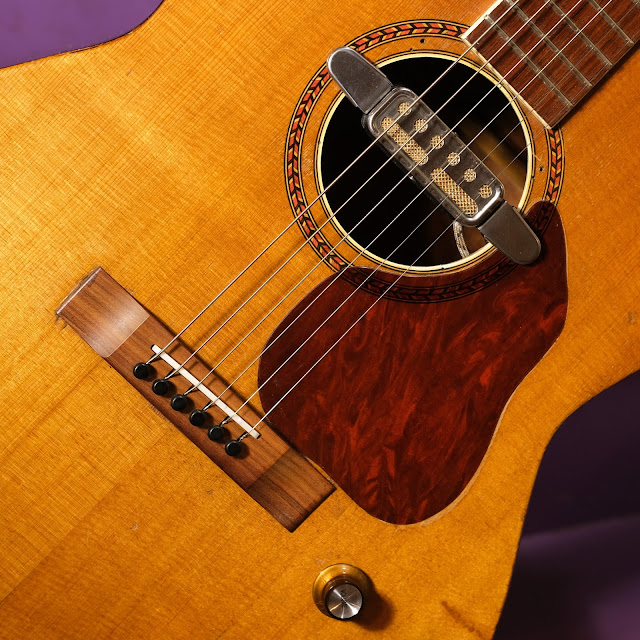1940s Regal "Milord" Dreadnought Guitar (Modded)
Regal made jumbo/dreadnought guitars of this shape and size from the very late '30s into the very early '50s, though they didn't make a whole lot of them. The most famous of them appeared in Grand Ole Opry sessions, though I'm blanking on the players seen with them. A few latter-era Washburn-branded ones even sported double-x-bracing under the hood, but most (like this one, when stock) had ladder-bracing and so sound a bit like a crisp-voiced 1960s Harmony Sovereign H1260.
Mr. Brandon sent this one in some time back and, like a quartet of others collecting dust on the shelves, it was in for a long-term rebracing job. I don't often have time to complete work like this in my regular schedule of glorified setups and average old-box work, so it's always exciting when one of these jobs is actually finished. Any time I have to take the back off of something work slows to a crawl. Here's what the new braces look like:
True to form, said stage-ready guitar has a Victory soundhole pickup and wiring harness installed and the K&K acoustic pickup at the endpin area got glued-down after I fit the new bridge. The old holes in the soundhole cut for a long-ago soundhole pickup got filled and touched-up, too.
It also had some old repairs done to it in the past -- newer frets and a neck reset and not-so-great replacement bridge were the most recent ones -- but aside from the rebracing job I also fixed the rest, too. Post-repairs it does sound really good -- it has punch, clarity, tons of piano-like sustain, and takes a lot of heavy-handed playing very well. These double-x guitars don't get woofy when driven hard and note-to-note balance all over the fretboard is even and clear. That might be my favorite feature -- it's great to play a guitar where you don't have to constantly think about hitting certain strings harder than others. The carbon fiber reinforcement in the braces seems to have made the top retain stiffness a lot better, too -- usually I expect a top to deflect a bit after stringing-up, but it hasn't budged at all in a few days. I think we win.
The K&K pickup sounds great, as you'd expect. At first I wasn't happy with the Victory magnetic pickup because the output was so low, but after padding it a little so it got closer to the strings I was actually really happy with the sound. It's a bit like an old Danelectro pickup -- clean and midsy-bright, excellent when given some bluesy drive, and with a dramatic drop-off in volume as it gets farther from the strings.
Repairs included: rebrace to double-x pattern, fret level/dress, side dots install, magnetic and piezo pickup installs, new rosewood-like (I forget the species) bridge, new bone saddle, cleaning, and setup.
Made by: Regal
Model: "Milord" jumbo
Made in: Chicago, IL, USA
Top wood: solid spruce
Back & sides wood: solid mahogany
Bracing type: double-x
Bridge: rosewood-like
Fretboard: rosewood
Neck wood: mahogany
Tone: crisp, clean, clear, balanced, lots of sustain, good punch
Action height at 12th fret: 3/32” bass 1/16” treble (fast, spot-on)
String gauges: 54w-12 lights (in this case D'Addario Monels)
Neck shape: medium C/D
Board radius: ~12"
Truss rod: non-adjustable
Neck relief: straight
Fret style: medium-modern
Scale length: 25 3/8"
Nut width: 1 3/4"
String spacing at nut: 1 9/16"
String spacing at bridge: 2 1/8"
Body length: 19 1/2"
Body width: 15 5/8"
Body depth: 4 7/8"
Weight: 4 lb 5 oz
Condition notes: replacement top bracing, replacement (StewMac repro) tuners, replacement bridge+saddle+pins, non-original soundhole pickup and wiring harness, replacement frets, replacement nut. There's a big ding on the treble side of the top near the knobs that's been there for ages, it looks like. There's a repaired hairline crack (longer) on one of the sides and general usewear and light scratching throughout. The back has some minor hairline cracking/finish muck here and there. At a glance, though, and aside from the magnetic pickup, it looks original. My new replacement bridge has a color that matches the milky "Regal rosewood" of the '40s in the fretboard and I cut it in a similar shape to the Regal bridges I have in my parts-stash.





















Comments